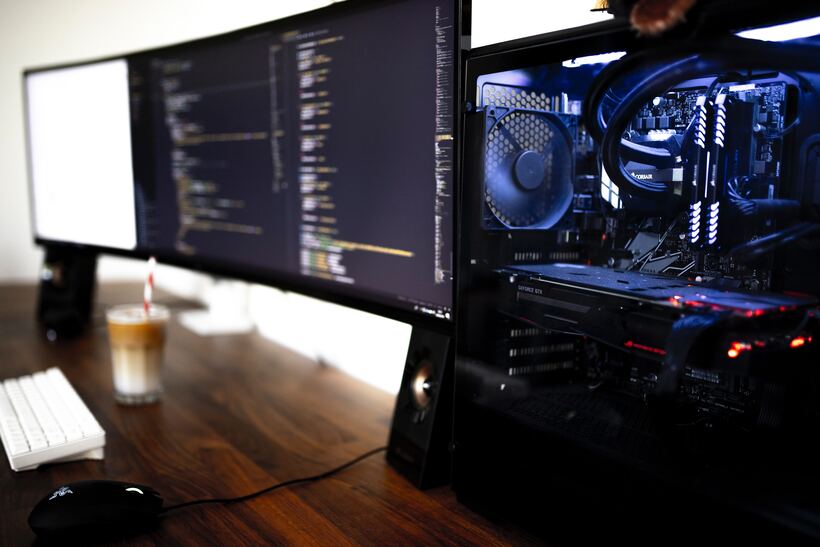
Welcome to the exciting world of indie game development, where creativity and technology collide in a harmonious symphony! In recent years, the emergence of artificial intelligence (AI) has revolutionized the way games are designed and played. Gone are the days when game developers relied solely on their imagination and coding skills to bring virtual worlds to life. With AI becoming an integral part of indie game development, possibilities have grown exponentially.
In this blog post, we will delve into the fascinating realm of AI in indie game development. We will explore how AI is not just another tool in a developer’s arsenal but rather a catalyst that bridges creativity with technological advancements. So fasten your seatbelts as we embark on an exhilarating journey through the ever-evolving landscape of AI-driven games!
Understanding the Role of AI in Game Design
AI, or Artificial Intelligence, has become an integral part of game design in recent years. It is no longer just a buzzword; it is a powerful tool that indie game developers can utilize to enhance gameplay and create immersive experiences for players.
One key role that AI plays in game design is enabling non-player characters (NPCs) to exhibit more realistic and dynamic behavior. Traditionally, NPCs would follow predetermined patterns or scripts, which could make them feel predictable and robotic. However, with the help of AI algorithms, NPCs can now adapt their actions based on player interactions and environmental factors.
Another important role of AI in game design is enhancing procedural generation systems. Procedural generation allows developers to generate vast amounts of content dynamically rather than handcrafting every aspect of the game world. With AI algorithms driving this process, games can have infinite variations while still maintaining coherence and balance.
AI can revolutionize player experience by creating intelligent opponents who challenge players at different skill levels. By analyzing player behavior and adjusting difficulty dynamically, AI-powered opponents ensure that each playthrough feels engaging and tailored to the individual’s skills.
In addition to these roles within gameplay mechanics, AI also assists designers in creating captivating narratives. Natural language processing techniques allow for more immersive dialogue systems where characters can understand context-based inputs from players.
The integration of machine learning algorithms into character animation systems also enables lifelike movements and expressions that enhance storytelling aspects within games.
Understanding the role of AI in game design opens up new possibilities for indie developers seeking innovative ways to captivate audiences through unique gameplay mechanics and compelling narratives. By harnessing the power of technology alongside creativity, indie games have the potential to push boundaries like never before!

Benefits of Using AI in Indie Games
Integrating artificial intelligence (AI) into indie game development has opened up a world of possibilities, revolutionizing the way games are created and experienced. The benefits of leveraging AI in indie games go far beyond just enhancing gameplay – it also enables developers to create immersive worlds, improve player engagement, and streamline the development process.
One significant advantage of using AI in indie games is its ability to enhance the overall gaming experience. With intelligent algorithms at work, NPCs (non-playable characters) can exhibit more realistic behavior and respond dynamically to player actions. This creates a more immersive environment where players feel like they’re interacting with living, breathing characters rather than scripted entities.
Another benefit is that AI can help optimize game design by automating time-consuming tasks such as level generation or playtesting. By utilizing machine learning algorithms, developers can generate procedural content that offers endless variations for players to explore. This not only saves valuable development time but also ensures that each playthrough feels fresh and unique.
AI-powered systems can analyze player data and adapt gameplay mechanics accordingly. This allows for personalized experiences tailored to individual preferences and skill levels. By tracking player behavior patterns and adjusting difficulty levels or suggesting customized quests or challenges, developers can provide a more engaging experience that keeps players hooked for longer periods.
Incorporating AI into indie games has proven to be cost-effective for small game studios with limited resources. Instead of relying solely on human designers or programmers for every aspect of the game’s development, AI tools enable solo developers or small teams to automate certain processes while focusing their efforts on other creative aspects.
The use of AI in indie game development brings numerous benefits ranging from enhanced gameplay experiences through realistic NPC behaviors to streamlining the development process itself by automating tedious tasks like level generation or playtesting.
Challenges and Limitations of AI in Game Development
While AI has made remarkable advancements in the field of game development, it still faces certain challenges and limitations. One key challenge is the balance between creativity and predictability. Games with overly predictable AI can quickly become boring for players, while games with overly creative AI may result in unpredictable and frustrating gameplay experiences.
Another challenge lies in the complexity of implementing AI systems. Developing sophisticated algorithms that can accurately mimic human behavior requires extensive time, resources, and expertise. Indie game developers often have limited budgets and smaller teams, making it more challenging to create complex AI systems.
There is a constant need to ensure that the AI behaves ethically within the game world. Developers must carefully consider potential biases or unintended consequences that may arise from their AI systems.
Debugging and fine-tuning an AI system can be a time-consuming process. It requires thorough testing across different scenarios to identify any issues or unwanted behaviors.
There are limitations imposed by hardware capabilities. While modern technology has significantly improved processing power, there are still constraints on what can be achieved due to computational limitations.
Despite these challenges and limitations, indie game developers continue to push boundaries by finding innovative solutions for incorporating AI into their games. By embracing these challenges as opportunities for growth and improvement, they pave the way for more immersive gaming experiences in the future.
Successful Examples of AI in Indie Games
Indie game developers have been harnessing the power of artificial intelligence (AI) to create unique and immersive gaming experiences. Let’s take a look at some successful examples where AI has played a pivotal role in enhancing gameplay.
In the indie game “Frostpunk,” developed by 11 bit studios, AI is used to simulate complex weather conditions and decision-making processes. Players must navigate through challenging scenarios while managing resources and making tough choices that impact their survival. The AI system dynamically responds to these decisions, creating a realistic and ever-changing environment.
Another notable example is “Slay the Spire” by Mega Crit Games. This deck-building roguelike game uses AI algorithms to generate randomized card encounters for players as they ascend the spire. The adaptive nature of the AI ensures that each playthrough offers different challenges, keeping players engaged and providing endless replayability.
“Into the Breach” from Subset Games showcases how AI can be utilized as an integral part of gameplay mechanics. In this turn-based strategy game, players control mechs battling against giant creatures known as Vek. The Vek are driven by advanced AI systems that adapt their strategies based on player actions, resulting in intense tactical battles.
The critically acclaimed indie title “Owlboy” by D-Pad Studio incorporates AI-controlled companions who assist players throughout their journey. These companions exhibit intelligent behavior patterns during combat situations, offering support and interacting with both enemies and environmental elements seamlessly.
These successful examples demonstrate how indie developers are leveraging AI technology to create dynamic worlds, engaging gameplay mechanics, and memorable experiences for gamers worldwide.
Tools and Resources for Implementing AI in Games
Implementing Artificial Intelligence (AI) in indie game development can seem like a daunting task, but fortunately, there are various tools and resources available to help streamline the process. These tools not only make it easier for developers to incorporate AI into their games but also enhance the overall gaming experience.
One popular tool is Unity, a game engine that provides built-in support for AI implementation. With Unity’s ML-Agents toolkit, developers can train intelligent agents using machine learning algorithms. This allows them to create NPCs (non-player characters) with realistic behaviors and decision-making abilities.
Another useful resource is TensorFlow, an open-source platform that enables deep learning. TensorFlow provides libraries and tools specifically designed for building neural networks, making it ideal for creating intelligent systems within games.
For developers looking to implement natural language processing (NLP) capabilities into their games, Natural Language Toolkit (NLTK) is a comprehensive library worth exploring. NLTK offers various functionalities such as tokenization, stemming, tagging, parsing, and semantic reasoning – all essential components of NLP-driven gameplay mechanics.
There are dedicated AI middleware solutions like Behavior Designer or Playmaker that provide visual scripting interfaces tailored towards implementing complex AI behaviors without extensive coding knowledge.
Cloud-based platforms like IBM Watson offer pre-trained models and APIs that allow developers to integrate advanced cognitive features such as speech recognition or sentiment analysis into their games with ease.
The availability of online communities and forums dedicated to AI in game development cannot be underestimated. Platforms like GitHub or Stack Overflow enable developers to share code snippets, trade insights, and seek guidance from experienced professionals who have already ventured into the realm of AI-powered indie gaming development.
Conclusion
In this fast-paced world of indie game development, where creativity and technology intertwine, AI has emerged as a powerful tool. Its ability to learn, adapt, and make decisions has revolutionized the way games are designed and played.
Through AI in indie game development, developers can create immersive worlds with dynamic environments and non-player characters that react intelligently to player actions. This not only enhances the overall gaming experience but also opens up new avenues for storytelling and gameplay mechanics.
The benefits of using AI in indie games are undeniable. It allows developers to streamline their workflow by automating certain tasks, such as generating procedural content or optimizing game performance. It also empowers them to experiment with innovative ideas that were previously unattainable due to resource constraints.
Despite these challenges, numerous successful examples demonstrate the potential of AI in indie games. From procedurally generated worlds like “No Man’s Sky” to intelligent enemy behavior in “Slay the Spire,” these games showcase how AI can elevate gaming experiences beyond what was once thought possible.
Looking ahead into the future of indie game development powered by AI is both exciting yet uncertain at times. As technology continues to advance rapidly, we can expect even more sophisticated forms of machine learning algorithms capable of creating truly unique experiences tailored specifically for individual players.

